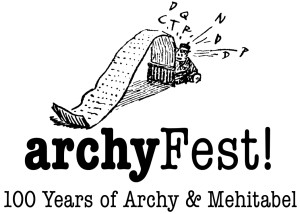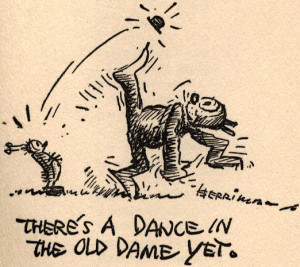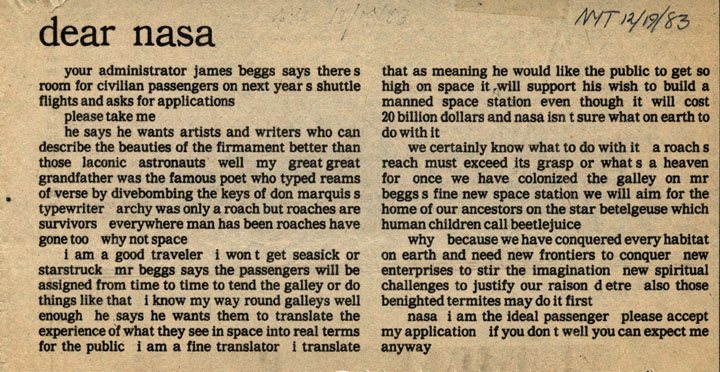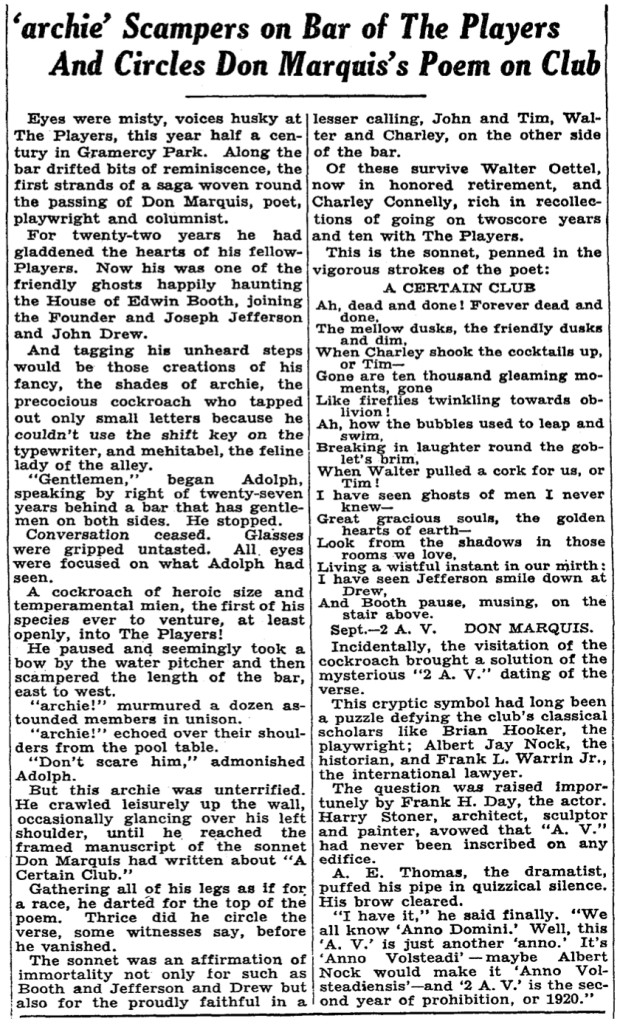Tag Archives: archy
Dave Barry Reads Archy and Mehitabel
 Second in a video series. Scroll down for a link to the video.
Second in a video series. Scroll down for a link to the video.
Archy the cockroach was the embodiment of reincarnation — he had been a poet in a past life, after all, and spent his insect days tapping out verse on a typewriter. So it’s entirely within reason to speculate who might be the reincarnation today of Don Marquis.
My vote would be for Dave Barry. Like Marquis, Barry was one of the most celebrated newspaper columnists of his era, using humor to shine a spotlight on the human condition. He wrote weekly columns in The Miami Herald from 1983 to 2005 that were devastatingly funny, and he won the Pulitzer Prize for commentary in 1988 for “his consistently effective use of humor as a device for presenting fresh insights into serious concerns.” Like Marquis, he has continued writing humor to great effect after leaving the grind of newspaper journalism, with 37 books to his name at last count.
The New York Times has called Barry “the funniest man in America.” The novelist Stephen King put it another way, declaring, “While reading Dave Barry’s ‘Big Trouble’ (Putnam, 1999), I laughed so loud I fell out of a chair. Luckily, there’s a rug, so I didn’t hurt myself.” On a personal level, one of Barry’s column’s from 1985 reduces this writer to disabling fits of laughter even today, after dozens of readings. It is titled “Ask Mr. Manners” and attempts to prepare a young parent for all the horrifying atrocities in store when hosting a birthday party for a preschool child. Popular themes for a young boy’s party, according to Barry, include action figures such as He-Man, G.I. Joe, The A-Team and the always-popular “Testosterone Bob’s Hurt Patrol.”
When he was asked to recite a few lines from “archy and mehitabel,” Barry chose an excerpt from one of the funniest distillations of humor ever put onto paper: “certain maxims of archy.” His video is short and sweet. It is the second in a series of self-made videos on the occasion of the 100th anniversary of Archy and Mehitabel’s first appearance in print, on March 29, 1916 — a yearlong celebration called archyFest.
Thank you, Dave Barry!
Here is his video:
These videos were conceived by John Batteiger, creator of DonMarquis.com, and edited by Brandon Cuicchi. We are asking a variety of public figures to take a video of themselves reading a selection from one of Marquis’s “archy” books, using a cellphone camera or other simple video recorder. Our goal: “One take, no big production, all for fun.” We plan to present a new video every week (or so) through the end of 2016. If you or someone you know would be interested in recording a video, please contact Batteiger by email at johnbatt (at) me.com.
Next week: Calvin Trillin!
Neil Gaiman Reads Archy and Mehitabel
 First in a video series. Scroll down for a link to the video.
First in a video series. Scroll down for a link to the video.
Novelist and comic-book writer Neil Gaiman counts Don Marquis’s “archy and mehitabel” among his favorite books. One of his top five, in fact.
Gaiman has mentioned Marquis in several interviews over the years, and he included Marquis in a rambling and fabulous statement of beliefs in his blockbuster 2001 novel, “American Gods,” in which one of the main characters, Samantha Black Crow, declares, in part: “I believe that the greatest poets of the last century were Edith Sitwell and Don Marquis, that jade is dried dragon sperm, and that thousands of years ago in a former life I was a one-armed Siberian shaman.”
Gaiman first read “archy and mehitabel” many years ago, and it continues to fascinate him. In a 2011 Australian radio broadcast, he included it in a discussion of his five most favorite books.
“Don Marquis was an American humorist and occasional poet and newspaper journalist, and he created Archy and Mehitabel,” Gaiman said on The Book Show, aired by ABC Radio National. “Archy was a free-verse poet who, for the crime of being a free-verse poet, was condemned to be a cockroach forevermore, in every future life, and he is a cockroach who writes poems by climbing on a typewriter and jumping head-first onto the keys. And Mehitabel is an alley cat who claims to have once been Cleopatra, and Don Marquis wrote these beautiful, funny, strange, mocking, glorious little poems about Archy and Mehitabel.”
Gaiman has won numerous international awards for his fantasy writing, including Carnegie and Newberry medals, so who better to lead off a video series featuring the wit and wisdom of a world-weary cockroach and a dissolute alley cat?
A few months ago, Gaiman was one of several writers, entertainers and other public figures asked to recite a few lines from one of the Archy and Mehitabel compilations (there are six) for a series of short, homemade videos on the occasion of the 100th anniversary of Archy and Mehitabel’s first appearance in print, on March 29, 1916 — part of a yearlong celebration called archyFest. Gaiman responded to the call immediately and enthusiastically, and the video below is the result.
Given the choice to read any of more that 300 published sketches and poems, Gaiman chose an obscure but brilliant sketch, “quote buns by great men quote,” from the 1927 book that started it all, “archy and mehitabel.” He explains:
I don’t know if this is my favorite of the Archy and Mehitabel poems. I do know that I fell in love with it before I actually understood what it meant. When I was a boy at school, a ‘bun’ was a large, doughy bread roll with raisins in it that you’d be given at four o’clock at school, and it was many, many years before I discovered that a bun was also 1920s slang — for a hangover.
Here is the video:
These videos were conceived by John Batteiger, creator of DonMarquis.com, and edited by Brandon Cuicchi. We are asking a variety of public figures to take a video of themselves reading a selection from one of Marquis’s “archy” books, using a cellphone camera or other simple video recorder. Our goal: “One take, no big production, all for fun.” We plan to present a new video every week (or so) through the end of 2016. If you or someone you know would be interested in recording a video, please contact Batteiger by email at johnbatt (at) me.com.
And thanks to Neil Gaiman for his gracious help and support!
Next week: Dave Barry!
It’s archyFest! 100 Years of Archy and Mehitabel!
 It was 100 years ago, on March 20, 1916, that Don Marquis added a fanciful bit of filler material to his daily newspaper column in The Evening Sun. He claimed that a cockroach had crawled onto his typewriter the night before and left a message by diving on the keys, one at a time. Many more messages would follow from the labors of Archy the cockroach, including wild tales of a neighborhood alley cat, Mehitabel. It was brilliant stuff, and it’s still with us today. Let’s celebrate!
It was 100 years ago, on March 20, 1916, that Don Marquis added a fanciful bit of filler material to his daily newspaper column in The Evening Sun. He claimed that a cockroach had crawled onto his typewriter the night before and left a message by diving on the keys, one at a time. Many more messages would follow from the labors of Archy the cockroach, including wild tales of a neighborhood alley cat, Mehitabel. It was brilliant stuff, and it’s still with us today. Let’s celebrate!
Plans in New York City include performances of actor Gale McNeeley’s one-man show, “Archy and Mehitabel”; a walking tour of New York’s old Newspaper Row on Sunday, March 27; and a special gathering of Marquis fans on the evening of Tuesday, March 29, at Jimmy’s No. 43, a bar/restaurant in the East Village, where tales will be told, Archy poems will be sung, and toasts will be raised to Don Marquis, Archy and Mehitabel.
Further events and exhibits will take place throughout 2016, all under the banner of archyFest! See below for event details: Continue Reading →
Modern Mehitabels
 The New York Times today printed obituaries for two women whose lives could not have been more dissimilar.
The New York Times today printed obituaries for two women whose lives could not have been more dissimilar.
Janet Wolfe, 101, was a New York socialite, “gleeful gadabout” and friend to some of the most powerful and creative men of the last century. Federico Fellini made passes at her, The Times noted, and Orson Welles sawed her in half in a magic show. Holly Woodlawn, 69, was a transgender actress who starred in Andy Warhol’s 1970 underground film “Trash” and was the inspiration for Lou Reed’s epic ballad “Walk on the Wild Side.”
Wolfe and Woodlawn had little in common except a rebellious spirit, bold and unstoppable, and a determination to wring every bit of life out of their time on this planet. So it’s no surprise that The Times has compared both women to Mehitabel, the brassy, bawdy alley cat whose adventures were captured in Don Marquis’s classic 1927 collection of tall tales and light verse, “archy and mehitabel.” The comparisons span many decades but are nonetheless fresh. Continue Reading →
A New Look for Archy (Several, In Fact)
George Herriman’s drawings of Archy and Mehitabel brilliantly capture the spirit of their subjects: the inquisitive cockroach and the sassy, brassy alleycat. To many most readers, the drawings are as much a part of Archy and Mehitabel’s charm as Don Marquis’s stories about them.
But Herriman was just one of many artists to capture their magic. Edward Gorey drew Archy and Mehitabel, and so did cartoonists at The New Yorker and Collier’s magazines. Animators drew them in a feature film, and artists today continue to draw inspiration from cockroach and cat.
Here is a look at Archy the cockroach through the eyes and pens and pencils of 10 artists, drawn over the course of nine decades. Scroll further down the page for an up-close look at each of the images. And look for drawings of Mehitabel in a future post.
Click on the thumbnail images below for full-size views: Continue Reading →
Barsotti Draws Archy in The New Yorker
Archy the cockroach has reappeared quite a few times in newspapers, magazines and blog posts in the decades after Don Marquis’s death. Check out this classic scene, drawn by the ace New Yorker cartoonist Charles Barsotti in 1973:
Barsotti was one of the most prolific and best-loved of The New Yorker’s stable of cartoonists. He drew 1,400 cartoons for The New Yorker, from the 1960s until his death in 2014, and was famous for simple line drawings of dogs and kings, outlaw snails and talking pasta. Here’s an appreciation, with lots of classic images, from the magazine’s cartoon editor.
Coming Saturday: Archy’s Typewriter in Boston
If you will be anywhere close to Boston this weekend, be sure to see the Blunderwood Portable typewriter in the Rose Kennedy Greenway. It’s a massive art installation on display Saturday and Sunday, part of Boston’s Figment Festival. Look for it where High Street intersects with the Greenway, northeast of South Station.
The Blunderwood, a 24:1 scale 1927 typewriter measuring 20 feet square and 8 feet tall, is an homage to Don Marquis’ Archy the cockroach.
Much like Archy, who dove head-first on the keys of Don’s typewriter to tell his stories, visitors to the Blunderwood will be able to walk on huge typewriter keys and see their own messages projected on an overhead screen made to look like an oversize sheet of typing paper. Several of Archy’s poems will also be projected. Continue Reading →
Archy Was Real, but That’s Not His Original Name
Here’s a thought that might keep you up at night: The real, live descendants of Archy the cockroach may be scurrying around the streets and alleyways and high-priced real estate of lower Manhattan at this very moment.
That’s right, Archy, the most famous insect in American literature, was based on a cockroach that once was very much alive. His home was in the newsroom of the old Evening Sun newspaper, but his real name was Erasmus, not Archy. Don Marquis revealed Archy’s origins and commented on his enduring appeal — and his frequent reincarnations — in an essay he wrote in 1934 for The Cornell Daily Sun, the student newspaper at Cornell University.
“Archy crawled into my life about twenty years ago, when I was doing a daily column on the New York Evening Sun,” Don wrote. “There was a story in the news columns about a garage up town somewhere that was haunted, . . . the type-writer in the garage office would keep clicking of nights, when no one was in there. So they thought it was a ghost, which is about what a lot of garage loafers would think. It didn’t occur to any of them to put a sheet of paper in the machine and give the ghost a chance to have his say. One night they found a mouse running back and forth on the keyboard; he was the ghost. Continue Reading →






